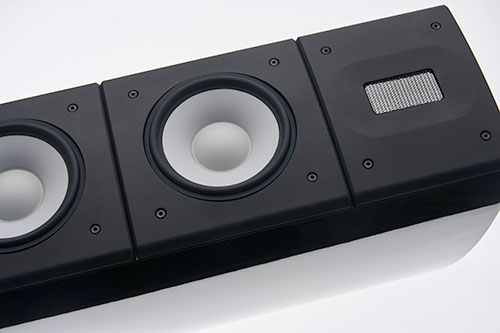
The sonic comparison of this integrated amplifier will be drawn from memory here. My previous, much more expensive reference combo comprising the Audio-gd preamplifier and the Air Tight ATM-3 tube monos ranges musically on an equal level in many aspects, but cannot keep up with the airiness of the sonic image and the colourful fine detailing of the completely handmade Power III. The marvelous musical enjoyment, once offered by the Cayin CS-805A and the Soundastic Reference, the amp from Lauffen is able to exceed from the musical perspective. It’s above all its sovereignty, which was immediately perceptible at first listening, and not even at high volume. Throughout all disciplines it doesn’t show any weaknesses when experiencing it as an integrated amplifier in conjunction with its digital converter stage. For this purpose, I chose my aged Wadia transport to supply the music from the CD via an S/PDIF connection. The Power III makes music very pleasantly and performs very filigree and homogeneous at the same time, independent of the volume. It is agile in terms of both fine and coarse dynamics and allows for or even gives the music its exciting fascination. Listening to the Power III or, more correctly, its playback of music in this configuration for hours on end is pure pleasure. Above all, it’s the airiness and depth of the spatial imaging that hoists it clearly ahead of my reference gear. At the same time, it doesn't thin out the sonic image, even if the bass range is reproduced enormously precise and slag-free. Thus, cellos and other low-frequent string instruments are rendered in a punchy and physically perceptible way. The music gets flowing and conveys a sense of rhythm.

To be able to evaluate the quality of the converter stage separately, I connect the Wadia transport to my Mutec re-clocker, which provides the newly clocked signal to my Antelope converter via a high-quality digital cable from Habst. I connect its output to the corresponding inputs on the Power III using equivalent balanced XLR cables and unbalanced RCA cables. This way I can assess the quality of the D/A converter and also determine if there are any audible sonic differences between balanced and unbalanced inputs using the chosen 1.5 meter cable length. Regarding the latter, I can sum it up briefly: I can't notice anything here that would be worth describing. To my ears, the inputs are sonically indistinguishable. Very noticeable, however, is the swapping to cables of higher quality, namely to the Siltech Classic Legend 680i. The musical performance rewarded this endeavour with finer resolution and structure. This external D/A converter alternative was quite expensive though. Almost 7000 euros would mark the expense also thanks to the high-quality Habst AES/EBU and Siltech cabling. But that makes no sense at all. The internal DAC sounds considerably better. Much more airiness and sense of space make the performance more appealing. The tonal balance features a less heavy bass end response, which definitely feels more authentic. On the Verve album The In Crowd performed by the Ramsey Lewis Trio, the spatial atmosphere and the musicians' enthusiasm is really palpable. The drum set sounds punchy and the different drum types are easily identifiable thanks to their individual timbres. There isn’t any doubt that listening through the integrated converter is more enjoyable in the end. The fine resolution lets the timbres bloom, thus conveying an exciting as well as easily accessible experience. To me, the compelling synthesis of converter and amplifier seems to be of particular importance, as probably the Power III will primarily attract owners of a digital sound source such as a streamer or a CD player/transport. In addition, there is still the USB input to be evaluated, to which I connect my laptop equipped with Roon via a Habst USB cable. Again, The In Crowd, this time streamed from Qobuz, serves as a comparison and I would now have to try very hard to express any differences. Via USB I can really enjoy high-res files, which I then do with fun for some days. For example, I streamed the Symphonies 1 - 4 from Brahms with Herbert Blomstedt and the Leipzig Gewandhaus Orchestra: simply wonderful! I also immensely enjoyed the recording, albeit only in CD quality, of Robert Schumann's Piano Concerto in A minor and Tchaikovsky's First Piano Concerto with Daniel Barenboim at the piano and the Munich Philharmonic conducted by Sergiu Celibidache. The airiness and musical beauty conveyed by the Power III here is something I have yet to hear with such fine detail on these speakers. As an endurance test, I followed up with Clara Schumann's Piano Concerto in A minor from the album Romance with Isata Kanneh-Mason at the piano. This is beautiful music to my ears, but packed into a very dense recording that most amplifiers fail to resolve. But not the Power III. It succeeds in decoding the recording so transparently that I enjoyed listening to this concerto and also to the following pieces written by Clara Schumann. Possibly it’s the high damping factor, the developers of Accustic Arts amplifiers always pay attention to, which might be also involved in this. As for the missing indication of the PCM resolution on the display, I didn’t miss it at all while streaming through all the Qobuz formats. If you want, you can easily verify these values at Roon. At this point, I have to confess that I mainly used the Audioquest Hurricane HC power cable for the listening tests, because I could already tell during the burn-in phase how much superior it is compared to the inexpensive MudraAkustik and how it elicits the Power III's capabilities even better: Especially in the lower frequency spectrum, more spatial depth and graduation can be experienced, and overall, the timbres are rendered in a more pronounced way. The Audioquest harmonizes perfectly with the Power III on the Mudra mains filter.


























 |
|


















































































